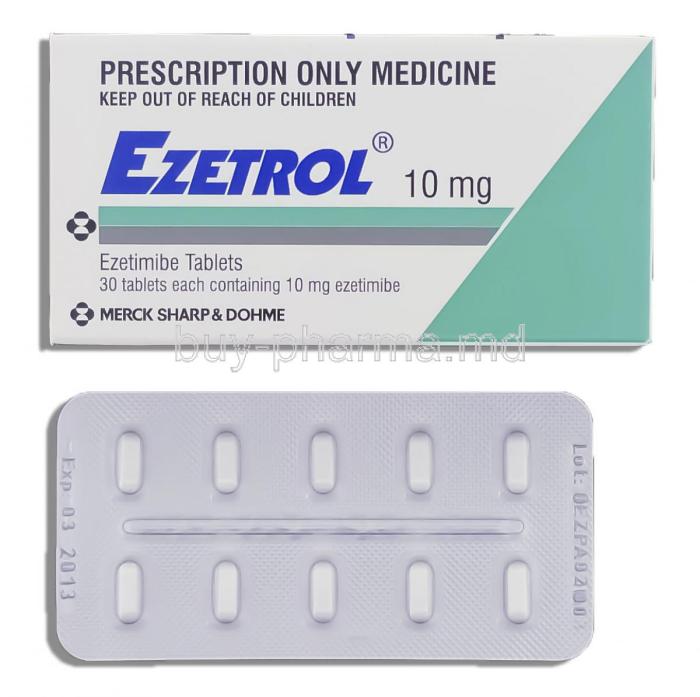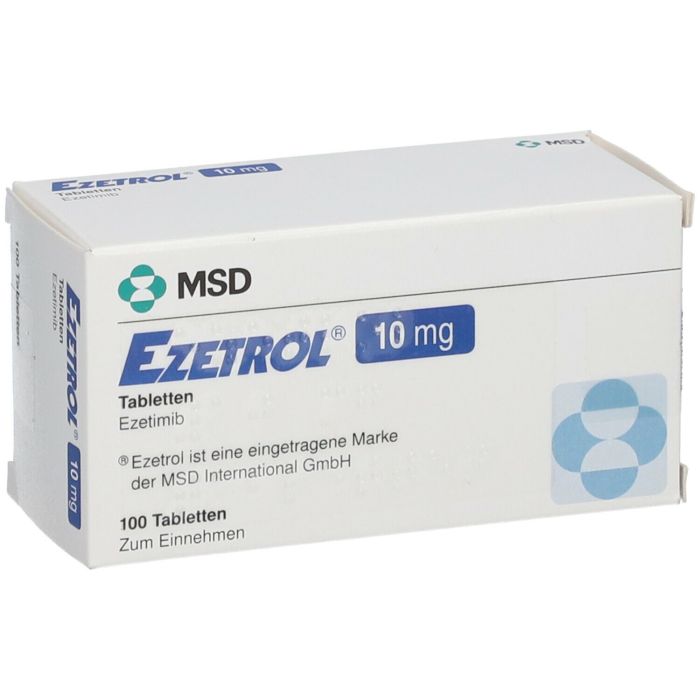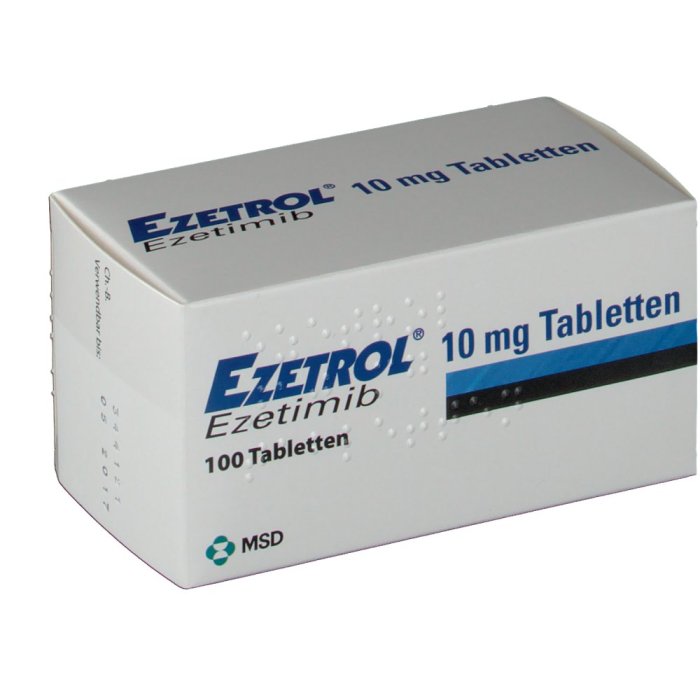Ezetrol sets the stage for this enthralling narrative, offering readers a glimpse into a story that is rich in detail and brimming with originality from the outset. Ezetrol, a medication used to manage cholesterol levels, stands out due to its unique mechanism of action. Unlike statins, which inhibit cholesterol synthesis, Ezetrol blocks the absorption of cholesterol in the gut, thereby reducing the amount of cholesterol circulating in the bloodstream. This targeted approach makes Ezetrol a valuable tool in the fight against high cholesterol and its associated cardiovascular risks.
Ezetrol is often prescribed in conjunction with statins to achieve optimal cholesterol reduction. It is also used for individuals who cannot tolerate statins or who do not experience adequate cholesterol control with statins alone. Ezetrol’s effectiveness in lowering cholesterol levels has been well-documented in clinical trials, and its safety profile is generally favorable. However, as with any medication, it is important to be aware of potential side effects and contraindications.
Ezetrol

Ezetrol, also known by its generic name ezetimibe, is a medication used to lower cholesterol levels in the blood. It plays a crucial role in managing high cholesterol, a condition that can increase the risk of heart disease and stroke.
Mechanism of Action
Ezetrol works differently from statins, another class of cholesterol-lowering drugs. While statins block the production of cholesterol in the liver, Ezetrol inhibits the absorption of cholesterol from the small intestine. This unique mechanism of action makes Ezetrol an effective treatment option for individuals who cannot tolerate statins or who require additional cholesterol reduction.
Chemical Structure and Properties
Ezetrol is a white to off-white crystalline powder with the chemical formula C23H29NO4. It is practically insoluble in water but soluble in organic solvents such as methanol and ethanol. The molecule consists of a complex structure with a central nitrogen atom attached to a benzene ring and a cyclohexane ring. This unique structure contributes to its selective inhibition of cholesterol absorption in the gut.
Clinical Applications of Ezetrol
Ezetrol (ezetimibe) is a cholesterol-lowering medication primarily used in conjunction with statins to effectively manage high cholesterol levels. It is a selective inhibitor of cholesterol absorption, preventing the absorption of dietary cholesterol in the small intestine.
Dosage and Administration Guidelines
Ezetrol is typically administered orally, once daily, with or without food. The recommended starting dose is 10 mg daily, and it can be adjusted based on individual patient characteristics and response to treatment.
The dosage of Ezetrol may be adjusted depending on the patient’s response to therapy and other factors, such as the severity of hypercholesterolemia and the presence of other medical conditions.
The following table Artikels the recommended dosage for Ezetrol in different patient populations:
| Patient Population | Recommended Dosage |
|---|---|
| Adults with hypercholesterolemia | 10 mg once daily |
| Children and adolescents (ages 10-17 years) with heterozygous familial hypercholesterolemia | 10 mg once daily |
Benefits of Ezetrol in Combination Therapy
Ezetrol, when used in combination with statins, offers several benefits for cholesterol management:
- Enhanced Cholesterol Reduction: Ezetrol works synergistically with statins to further lower LDL cholesterol levels, achieving greater reductions compared to either drug alone.
- Improved Patient Outcomes: Studies have demonstrated that combination therapy with Ezetrol and statins leads to improved cardiovascular outcomes, including reduced risk of heart attacks and strokes.
- Alternative for Statin Intolerance: For individuals who cannot tolerate statins due to adverse effects, Ezetrol in combination with other cholesterol-lowering medications can be a viable option.
Pharmacokinetics and Metabolism of Ezetrol

Ezetrol, also known as ezetimibe, is a medication used to lower cholesterol levels. It works by blocking the absorption of cholesterol from the small intestine. Understanding the pharmacokinetics of Ezetrol is crucial for its effective and safe use. This section will delve into the absorption, distribution, metabolism, and excretion of Ezetrol in the body. It will also discuss factors that may influence the pharmacokinetics of Ezetrol, such as age, gender, and kidney function. Finally, potential drug interactions of Ezetrol with other medications will be analyzed.
Absorption
Ezetrol is rapidly absorbed from the gastrointestinal tract. Peak plasma concentrations are typically reached within 1 to 2 hours after oral administration. The absorption of Ezetrol is not significantly affected by food.
Distribution
After absorption, Ezetrol is widely distributed throughout the body. It binds extensively to plasma proteins, primarily albumin. Ezetrol crosses the blood-brain barrier to a limited extent.
Metabolism
Ezetrol is primarily metabolized in the liver by the cytochrome P450 system, specifically by CYP3A4. It undergoes extensive first-pass metabolism, meaning a significant portion of the drug is metabolized before reaching systemic circulation. The major metabolites of Ezetrol are inactive.
Excretion
Ezetrol and its metabolites are excreted primarily in the feces, with a small amount excreted in the urine. The elimination half-life of Ezetrol is approximately 22 hours.
Factors Influencing Pharmacokinetics
Age
The pharmacokinetics of Ezetrol is generally similar in elderly patients compared to younger adults. However, elderly patients may have a slightly lower clearance of Ezetrol, leading to higher plasma concentrations.
Gender
There are no significant differences in the pharmacokinetics of Ezetrol between men and women.
Kidney Function
Ezetrol is primarily eliminated in the feces. Therefore, renal function does not significantly affect the pharmacokinetics of Ezetrol.
Drug Interactions
Ezetrol can interact with other medications. Some of the important drug interactions include:
Strong CYP3A4 Inhibitors
Strong inhibitors of CYP3A4, such as ketoconazole, itraconazole, clarithromycin, and grapefruit juice, can increase the plasma concentrations of Ezetrol. This may lead to an increased risk of adverse effects.
Fibrates
Ezetrol can increase the plasma concentrations of fibrates, such as gemfibrozil and fenofibrate. This interaction may increase the risk of myopathy.
Cholestyramine
Cholestyramine, a bile acid sequestrant, can decrease the absorption of Ezetrol. Therefore, these medications should be administered at least 4 hours apart.
Safety and Efficacy of Ezetrol
Ezetrol (ezetimibe) is a medication used to lower cholesterol levels in the blood. It works by inhibiting the absorption of cholesterol from the small intestine. Ezetrol is typically used in conjunction with statins, but it can also be used alone in patients who cannot tolerate statins.
Clinical Trial Data Supporting Ezetrol’s Efficacy
Ezetrol’s efficacy in reducing cholesterol levels has been established through numerous clinical trials. These trials have demonstrated that Ezetrol effectively lowers both low-density lipoprotein (LDL) cholesterol, often referred to as “bad” cholesterol, and total cholesterol levels.
Here’s a summary of key findings from clinical trials:
* IMPROVE-IT Trial: This large-scale trial involved over 18,000 patients with coronary heart disease. Patients were randomly assigned to receive either ezetimibe in addition to simvastatin or simvastatin alone. The results showed that ezetimibe, when added to simvastatin, significantly reduced the risk of major cardiovascular events, including heart attack, stroke, and cardiovascular death.
* SHARP Trial: This trial included over 9,000 patients with high cholesterol levels. Patients were randomly assigned to receive either ezetimibe in addition to simvastatin or simvastatin alone. The trial demonstrated that ezetimibe, in combination with simvastatin, significantly reduced LDL cholesterol levels compared to simvastatin alone.
* Other Trials: Numerous other clinical trials have consistently demonstrated the efficacy of ezetimibe in lowering cholesterol levels, both when used alone and in combination with statins.
Potential Adverse Effects of Ezetrol
While generally well-tolerated, Ezetrol can cause some adverse effects. The most common side effects are usually mild and include:
* Gastrointestinal issues: These can include diarrhea, abdominal pain, and nausea.
* Muscle aches and pain: These are less common but can occur, especially when Ezetrol is used in combination with statins.
* Liver enzyme elevations: These are usually mild and temporary, but in rare cases, can indicate liver damage.
Contraindications and Precautions for Ezetrol Administration
Ezetrol is contraindicated in patients with:
* Active liver disease: Ezetrol can potentially worsen liver function in patients with pre-existing liver problems.
* Pregnancy and breastfeeding: The safety of Ezetrol in pregnant and breastfeeding women has not been established.
* Known hypersensitivity to ezetimibe: Patients with a history of allergic reactions to ezetimibe should avoid using the medication.
Precautions should be taken when administering Ezetrol to patients with:
* Kidney disease: Ezetrol is primarily eliminated by the liver, and kidney function does not significantly affect its metabolism. However, caution is advised in patients with severe kidney disease.
* Concurrent use of other medications: Ezetrol can interact with certain medications, such as statins, fibrates, and ciclosporin. It’s crucial to inform healthcare professionals about all medications being taken, including over-the-counter drugs and herbal supplements.
* Monitoring: Regular monitoring of liver function and cholesterol levels is recommended during Ezetrol therapy.
Ezetrol and Lifestyle Modifications

Ezetrol, while effective in lowering cholesterol levels, works best when combined with lifestyle modifications. Adopting a heart-healthy lifestyle can significantly enhance the effectiveness of Ezetrol and improve overall cardiovascular health. This approach not only helps manage cholesterol but also reduces the risk of heart disease and stroke.
Dietary Recommendations
Dietary changes are crucial in managing cholesterol levels. Here are some recommendations:
- Reduce saturated and trans fats: These fats raise LDL (bad) cholesterol. Limit intake of red meat, full-fat dairy products, fried foods, and processed foods.
- Increase intake of soluble fiber: This type of fiber binds to cholesterol in the gut and helps remove it from the body. Good sources include oats, beans, lentils, fruits, and vegetables.
- Choose lean protein sources: Opt for fish, poultry without skin, beans, and tofu over red meat.
- Limit cholesterol intake: Avoid foods high in cholesterol, such as egg yolks, shellfish, and organ meats.
- Reduce sugar intake: Excess sugar can contribute to weight gain and increase triglyceride levels, which can negatively impact cholesterol levels.
Exercise Regimens, Ezetrol
Regular physical activity is essential for maintaining healthy cholesterol levels and improving cardiovascular health. Here are some recommendations:
- Aim for at least 30 minutes of moderate-intensity exercise most days of the week: This could include brisk walking, jogging, swimming, cycling, or dancing.
- Include strength training exercises at least twice a week: This helps build muscle mass, which can improve cholesterol levels.
- Choose activities you enjoy: This will make it easier to stick with your exercise routine.
Benefits of Lifestyle Modifications
Lifestyle changes can significantly enhance the effectiveness of Ezetrol and improve overall cardiovascular health.
- Improved cholesterol levels: Combining Ezetrol with lifestyle modifications can lead to a greater reduction in LDL cholesterol levels compared to Ezetrol alone.
- Reduced risk of heart disease and stroke: By lowering cholesterol and improving cardiovascular health, lifestyle modifications can significantly reduce the risk of developing heart disease and stroke.
- Weight management: Dietary changes and exercise can help maintain a healthy weight, which is crucial for managing cholesterol levels.
- Increased energy levels: Regular exercise can boost energy levels and improve overall well-being.
- Improved mental health: Physical activity has been shown to reduce stress, anxiety, and depression, leading to improved mental health.
Ezetrol and Cardiovascular Disease
Ezetrol, a cholesterol-lowering medication, plays a significant role in the prevention and management of cardiovascular disease (CVD), including coronary artery disease (CAD) and stroke. Its mechanism of action, targeting the absorption of cholesterol in the gut, contributes to a reduction in low-density lipoprotein (LDL) cholesterol levels, a key factor in the development of CVD.
Ezetrol in the Prevention and Management of Cardiovascular Disease
Ezetrol’s effectiveness in reducing the risk of cardiovascular events has been demonstrated through numerous clinical trials. These studies have shown that Ezetrol, when used alone or in combination with statins, can significantly lower LDL cholesterol levels and, consequently, reduce the risk of major adverse cardiovascular events (MACE), such as heart attack, stroke, and cardiovascular death.
Evidence Supporting the Use of Ezetrol in Reducing the Risk of Cardiovascular Events
The landmark IMPROVE-IT trial, a large-scale clinical study involving over 18,000 patients with a history of acute coronary syndrome, provided compelling evidence for the benefits of Ezetrol in reducing cardiovascular risk. The trial showed that adding Ezetrol to standard statin therapy resulted in a significant reduction in the risk of MACE, including a 6.4% reduction in the risk of major coronary events and a 7.9% reduction in the risk of stroke.
Potential Benefits of Ezetrol in Combination with Other Cardiovascular Medications
Ezetrol can be effectively combined with other cardiovascular medications, such as statins, to achieve optimal cholesterol control and reduce the risk of CVD. This combination therapy has been shown to be particularly beneficial for patients with high cholesterol levels or those who have not achieved their target LDL cholesterol levels with statins alone.
“Ezetrol, when combined with statins, can effectively reduce LDL cholesterol levels and the risk of cardiovascular events in patients with high cholesterol or those who have not achieved their target LDL cholesterol levels with statins alone.”
Ezetrol: Current Research and Future Directions
Ezetrol, while primarily known for its role in cholesterol management, is currently being investigated for its potential applications in other health conditions and its future directions hold promise for personalized medicine approaches. Ongoing research explores the potential of Ezetrol beyond its established role in lowering cholesterol levels.
Ezetrol in Other Health Conditions
Research is exploring the potential benefits of Ezetrol in various health conditions beyond its established role in lowering cholesterol levels.
- Neurological Disorders: Studies are investigating Ezetrol’s potential in treating Alzheimer’s disease, Parkinson’s disease, and multiple sclerosis. Research suggests that Ezetrol may play a role in reducing inflammation and oxidative stress in the brain, which are implicated in these conditions.
- Cancer: Some studies suggest that Ezetrol might have anti-cancer properties. Research is exploring its potential role in preventing and treating certain types of cancer, including breast cancer, colorectal cancer, and prostate cancer.
- Inflammatory Conditions: Ezetrol’s ability to reduce inflammation is being explored in conditions like rheumatoid arthritis, inflammatory bowel disease, and lupus. Research suggests that Ezetrol may help manage inflammation and improve symptoms in these conditions.
Future Directions for Ezetrol Research
Research on Ezetrol is continually evolving, exploring new formulations, combination therapies, and personalized medicine approaches.
- Novel Formulations: Scientists are developing new formulations of Ezetrol, such as extended-release versions, to improve its efficacy and convenience. This could lead to better patient adherence and improved cholesterol management.
- Combination Therapies: Combining Ezetrol with other cholesterol-lowering drugs, like statins, is being investigated to achieve more significant reductions in cholesterol levels. This approach may be particularly beneficial for patients with high cholesterol levels or those who are not adequately responding to statins alone.
- Personalized Medicine: Ezetrol’s role in personalized medicine is gaining traction. Researchers are exploring genetic testing to identify individuals who may benefit most from Ezetrol therapy. This personalized approach aims to optimize cholesterol management by tailoring treatment to individual patient needs.
Ezetrol emerges as a significant player in the field of cholesterol management, offering a unique and effective approach to lowering cholesterol levels. Its targeted mechanism of action, combined with its proven efficacy and generally favorable safety profile, makes it a valuable option for individuals seeking to improve their cardiovascular health. While lifestyle modifications remain crucial, Ezetrol provides a valuable tool for those who require additional support in managing their cholesterol levels.
Ezetrol, a medication commonly used to lower cholesterol levels, is often prescribed alongside statins for maximum effectiveness. While statins focus on reducing the production of cholesterol, Ezetrol targets the absorption of cholesterol in the gut. To further understand the intricate workings of cholesterol management, it’s helpful to explore other medications like inspra , which focuses on regulating blood pressure.
The combination of these medications, along with lifestyle changes, can significantly contribute to achieving healthy cholesterol levels and overall cardiovascular well-being.